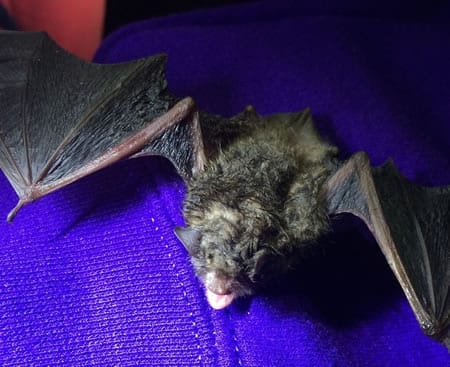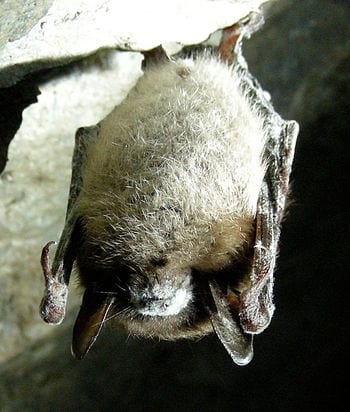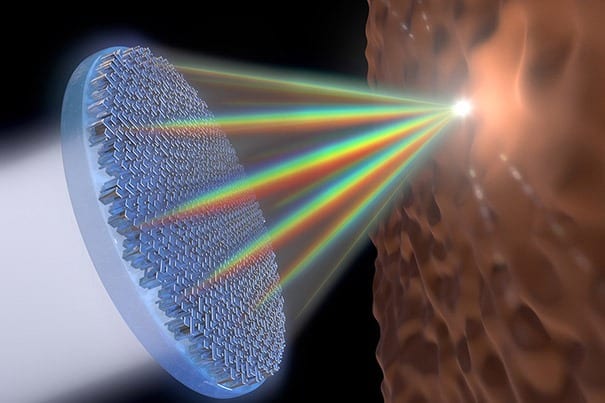
The fungus behind white-nose syndrome, a disease that has ravaged bat populations in North America, may have an Achilles’ heel: UV light. White-nose syndrome has spread steadily for the past decade and is caused by the fungus Pseudogymnoascus destructans, known as P. destructans or Pd.
In the course of genomic analyses of P. destructans, a team of scientists from the U.S. Forest Service, U.S. Department of Agriculture and the University of New Hampshire found that the fungus is highly sensitive to UV light. P. destructans can only infect bats during hibernation because it has a strict temperature growth range of about 39-68 degrees Fahrenheit. However, treating bats for the disease during hibernation is challenging, so any weakness of the fungus may be good news to managers trying to develop treatment strategies.
In a study published on Jan. 2 in the journal Nature Communications titled “Extreme sensitivity to ultra-violet light in the fungal pathogen causing white-nose syndrome of bats,” the research team suggests that P. destructans is likely a true fungal pathogen of bats that evolved alongside bat species in Europe and Asia for millions of years, allowing Eurasian bats to develop defenses against it. In the course of comparing P. destructans to six closely related non-pathogenic fungi, researchers discovered that P. destructans is unable to repair DNA damage caused by UV light, which could lead to novel treatments for the disease. The study, which was funded by the U.S. Fish and Wildlife Service, is available at: https://www.nrs.fs.fed.us/pubs/55557
“This research has tremendous implications for bats and people,” said Tony Ferguson, Director of the Forest Service’s Northern Research Station and the Forest Products Laboratory. “Bats play a key role in the health of forests as well as the production of food in the United States, and developing an array of tools with which we can treat bats for white-nose syndrome is important to preserving these very important species.”
The research team generated annotated genomes for P. destructans as well as six non-pathogenic Pseudogymnoascus species in an effort to gain insight into the origins and adaptations of the fungal pathogen of WNS. Using comparative genomics, the research team noticed that P. destructans lacked a key DNA repair enzyme, prompting them to expose the fungi to DNA damaging agents, including different wavelengths and intensities of UV light. They found that a low dose exposure of UV-C light resulted in about 15 percent survival of P. destructans while a moderate dose exposure resulted in less than 1 percent survival. These values translate to only a few seconds of exposure from a hand-held UV-C light source.
“It is unusual that P. destructans appears to be unable to repair damage caused by UV-light,” said Jon Palmer, a research botanist in the Northern Research Station’s lab in Madison, Wis., and the lead author of the study. “Most organisms that have been found in the absence of light maintain the ability to repair DNA caused by UV light radiation. We are very hopeful that the fungus’ extreme vulnerability to UV light can be exploited to manage the disease and save bats.”
“White-nose syndrome is the single biggest threat to many North American bat species and one of the most pressing conservation challenges facing America’s wildlife today,” said Jeremy Coleman, national white-nose syndrome coordinator, U.S. Fish and Wildlife Service. “Investing in defeating WNS must be a priority, and the results from this study and contributing research give us hope that we can develop the tools to more effectively manage the fungus that causes the disease.”
Research on potential treatment using UV light is under way. Daniel Lindner, a research plant pathologist with the Northern Research Station in Madison and the corresponding author on the study, is leading follow-up research to determine if UV-light can be used as a treatment for bats suffering from white-nose syndrome. The study will measure the survival of little brown bats during hibernation after being treated with UV-light compared to control groups. The researchers are also exploring whether there are any non-target effects by measuring changes in the bat skin microbiome (both fungal and bacterial communities). The study, which is funded by a grant from the, National Fish and Wildife Foundation, Bats for the Future Fund began late last year.
Learn more: Lethal fungus that causes white-nose syndrome may have an Achilles` heel, new study reveals
The Latest on: White-nose syndrome
[google_news title=”” keyword=”white-nose syndrome” num_posts=”10″ blurb_length=”0″ show_thumb=”left”]- Black dog turns completely WHITE due to rare condition leaving owner stunned at two-year transformationon April 29, 2024 at 12:58 pm
A BLACK dog has turned completely white due to a rare condition, leaving its owner stunned by the shocking transformation. Buster, a cute four-year-old pup from Oklahoma, got his fur colour ...
- Deadly bat disease could mean trouble for agriculture industryon April 21, 2024 at 11:15 pm
After two bats were found in Longmont and Boulder last month with white nose syndrome, a fungal disease that has decimated bat populations in the Midwestern and Eastern U.S., Colo ...
- Two Colorado bats found with white-nose syndrome; disease could have 'devastating' impacton March 28, 2024 at 4:09 am
Colorado’s first recorded case of white-nose syndrome, a destructive, fungus-caused wildlife disease that has killed millions of North American bats since it was first documented in the United ...
- News tagged with white-nose syndromeon March 26, 2024 at 5:00 pm
In a new study, researchers have found that little brown bats suffering from white-nose syndrome (WNS) greatly increased their foraging activity at artificial bug buffets. The buffets, located ...
- White-nose Syndromeon March 10, 2024 at 4:57 am
A fungal disease considered one of the worst wildlife diseases in modern times. White-nose syndrome has resulted in millions of bat deaths in North America since its introduction in the early 2000’s.
- White-nose syndrome arrives: Colorado bat tests positive for fatal diseaseon April 24, 2023 at 10:29 am
White-nose syndrome, a fungal disease that has decimated bat populations in the eastern U.S. and Canada, has been detected in Colorado for the first time. A female Yuma bat was found on the ground ...
- BAT CRISIS: WHITE-NOSE SYNDROMEon August 18, 2020 at 1:29 pm
A fast-moving disease is killing bats across North America. We need your help to stop it. White-nose syndrome has killed millions of bats since it was first discovered in the U.S. Northeast in 2006.
- Endangered Species Recovers, in Rare Good News for Batson April 16, 2018 at 5:00 pm
With bats — important pollinators and insect pest controllers — under siege from white-nose syndrome, the Chiroptera animal order got some rare good news Tuesday, when the Fish and Wildlife Service ...
- Have scientists found an Achilles heel for white-nose syndrome?on April 3, 2018 at 5:00 pm
White-nose syndrome is a fatal disease that has devastated bat populations in parts of the United States and Canada. In a recent study published by the USDA Forest Service Northern Research Station, a ...
- The Trouble With Batson March 17, 2016 at 10:03 am
A decade after the emergence of white-nose syndrome, bats in national parks and around the country continue to die. Can researchers save them before it’s too late? We’re driving along the northern ...
via Google News and Bing News










